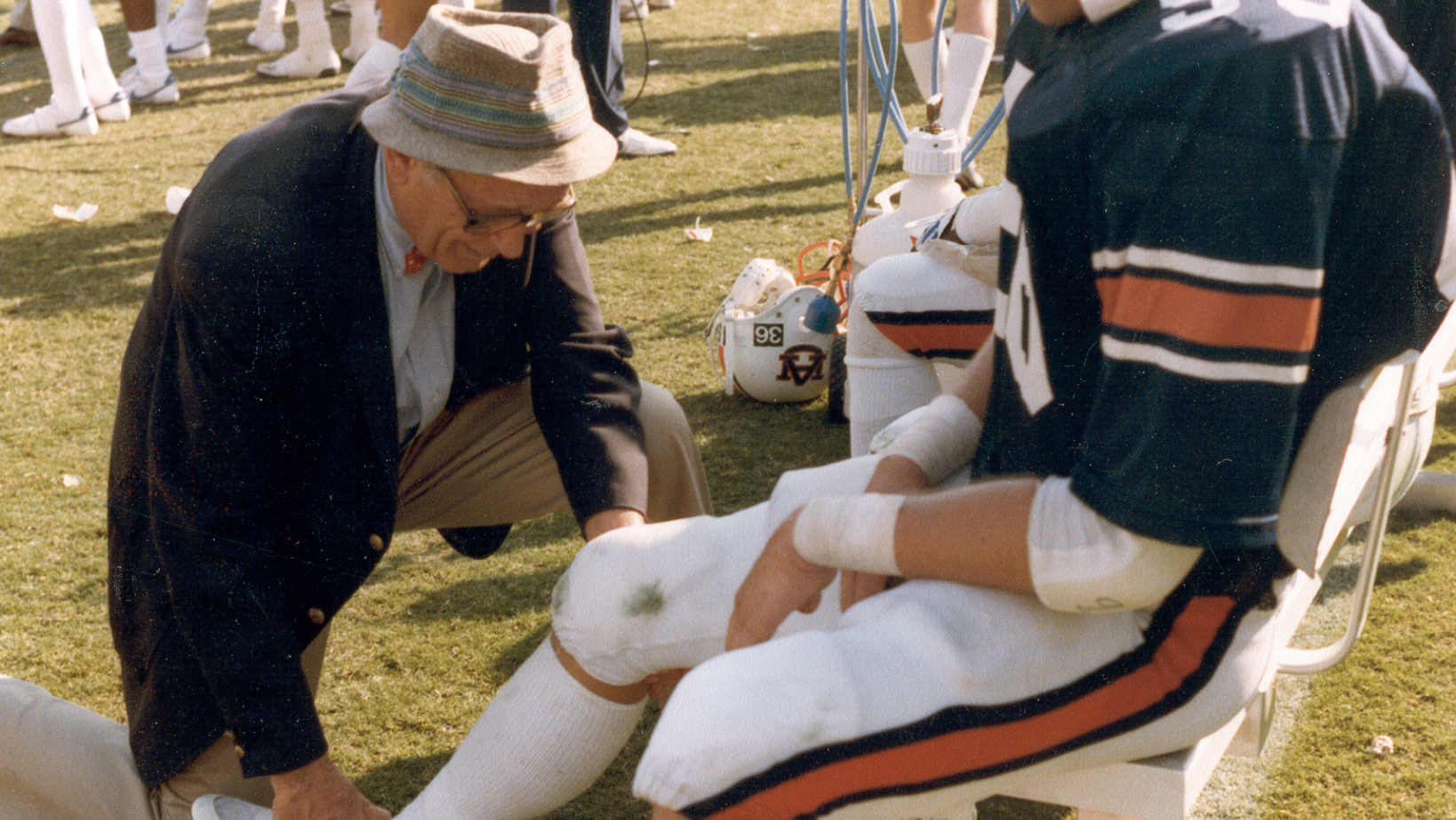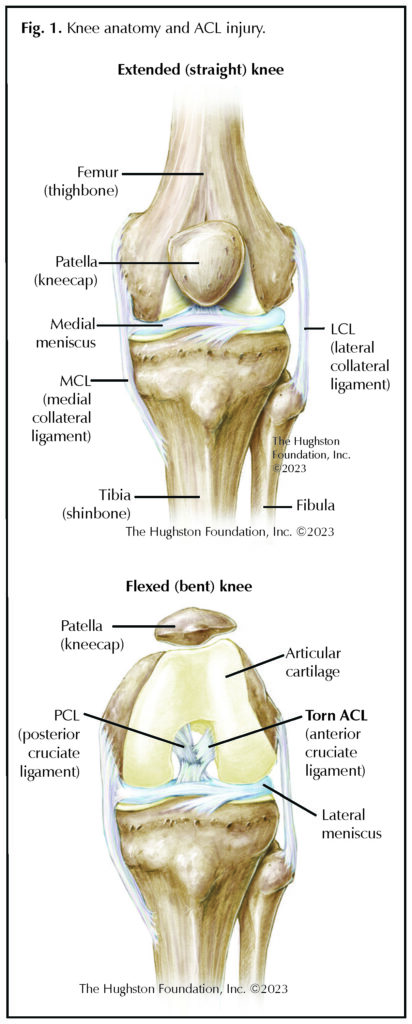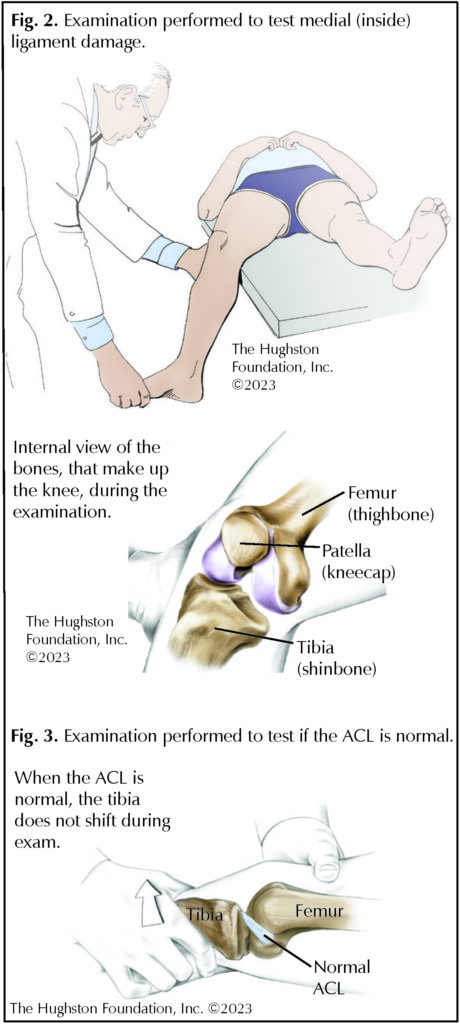
In 1992, Dr. Jack C. Hughston (1917-2004), one of the world’s most respected authorities on knee ligament surgery, shared some of his thoughts regarding injuries to the ACL.
“You tore your anterior cruciate ligament.” On hearing your physician speak those words, you are filled with a sense of dread. You envision the end of your athletic life, even recreational sports.
 Today, a torn ACL (Fig. 1) has almost become a household word. Through friends, newspapers, television, sports magazines, and even our physicians, we are inundated with the hype that the knee joint will deteriorate and become arthritic if the ACL is not operated on as soon as possible.
Today, a torn ACL (Fig. 1) has almost become a household word. Through friends, newspapers, television, sports magazines, and even our physicians, we are inundated with the hype that the knee joint will deteriorate and become arthritic if the ACL is not operated on as soon as possible.
You have been convinced that to save your knee you must have an operation immediately to repair the ligament. Your surgery is scheduled for the following day. You are scared. But there is an old truism in orthopaedic surgery that says, “no knee is so bad that it can’t be made worse by operating on it.”
For many years, torn ACLs were treated as an emergency and were operated on immediately, even before the initial pain and swelling of the injury subsided.
The trauma of the injury, plus the trauma of the operation added insult to injury, often resulting in the formation of scar tissue. Sometimes the results were stiff, painful knees without normal motion or function. The result was knees that caused the patient disability, even with simple walking.
Over the years, I have had to try to correct these problem knees. Those that were less stiff often responded to concentrated rehabilitation exercises and regained acceptable functional status. Others, however, required surgical release, and some had to have multiple operations to remove scar tissue to loosen the joint.
Isn’t there an alternative to this all too common scene? Another treatment approach that isn’t as frightful? The answer is a definite “YES”! In many instances, nonsurgical treatment is successful. In other cases, surgery is necessary. Immediate surgery may be needed to repair other ligaments and torn menisci in the knee. But if only the ACL is torn, immediate repair is not necessary.
 If the knee is shown to be loose during the physical exam, then most likely other ligaments in addition to the ACL have been damaged (Fig. 2). These other ligaments, when torn badly enough, may need to be surgically repaired within the first week. After they have been repaired and after a good rehabilitation program of 6 or more months, the decision to reconstruct the ACL can be made. If, at this time, there is a functional need for a ligament replacement, the operation can be done without the risk of subsequent stiffness and disability that can result from emergency repairs of the ACL.
If the knee is shown to be loose during the physical exam, then most likely other ligaments in addition to the ACL have been damaged (Fig. 2). These other ligaments, when torn badly enough, may need to be surgically repaired within the first week. After they have been repaired and after a good rehabilitation program of 6 or more months, the decision to reconstruct the ACL can be made. If, at this time, there is a functional need for a ligament replacement, the operation can be done without the risk of subsequent stiffness and disability that can result from emergency repairs of the ACL.
If only the ACL is torn, it may be difficult for your physician to confirm any looseness or instability of the knee joint by physical exam (Fig. 3). I have seen cases where the ACL tear was only diagnosed by MRI or some other form of imaging study, and based on those findings, the patients were advised to have immediate surgery to repair the ligament. Be wary of this sort of advice. If your knee is not loose enough for your physician to be able to physically demonstrate the instability to you, then you should get a second opinion before having surgery.
In other cases, when the ACL and other ligaments are damaged and there is significant joint instability, surgery can be planned when the pain and swelling have subsided and knee motion has returned to almost normal. This usually occurs 6 weeks or more after the injury, in the meantime, you will have been performing prescribed daily rehabilitation exercises and using crutches to aid with your walking. When the knee is re-examined, there will be less discomfort and your physician will be able to perform a better evaluation. If the looseness is severe enough, an ACL reconstruction can be performed and the chance of complications is less than with an emergency operation.
The important thing to remember in all of this is that you don’t need to be frightened that your knee will be ruined forever if the torn ACL is not repaired immediately. On the contrary, a torn ACL by itself is not a reason for emergency surgery. Rather, it is time for calm, conservative management and appropriate follow-up. If this does not seem to be the approach your physician is taking, don’t hesitate to get a second opinion.
A remembrance of Jack C. Hughston, MD (1917-2004)
Celebrating his life and legacy, 19 years since his passing.
Reprinted from the Hughston Health Alert: Volume 4, Number 4, Fall 1992.
Last edited on April 19, 2023